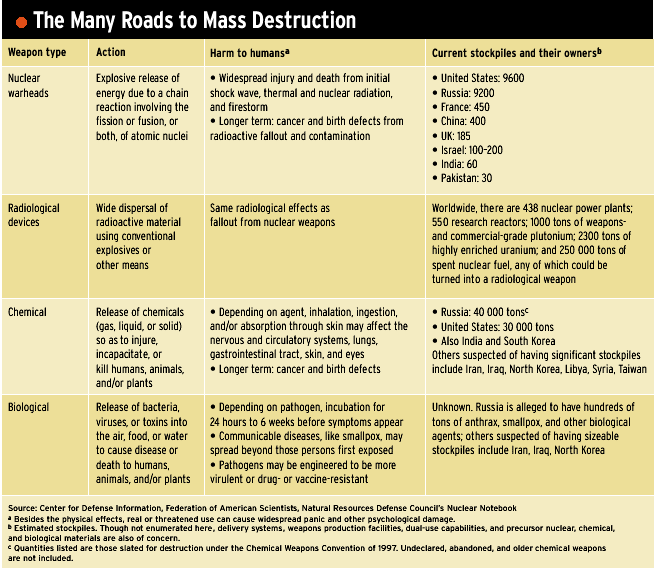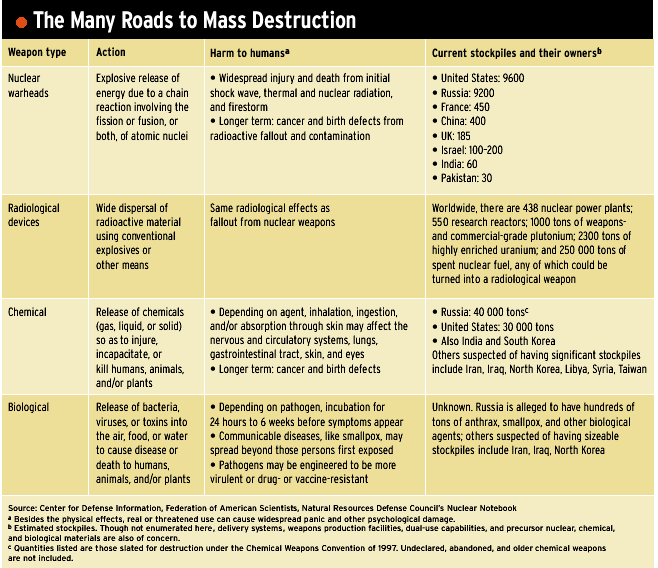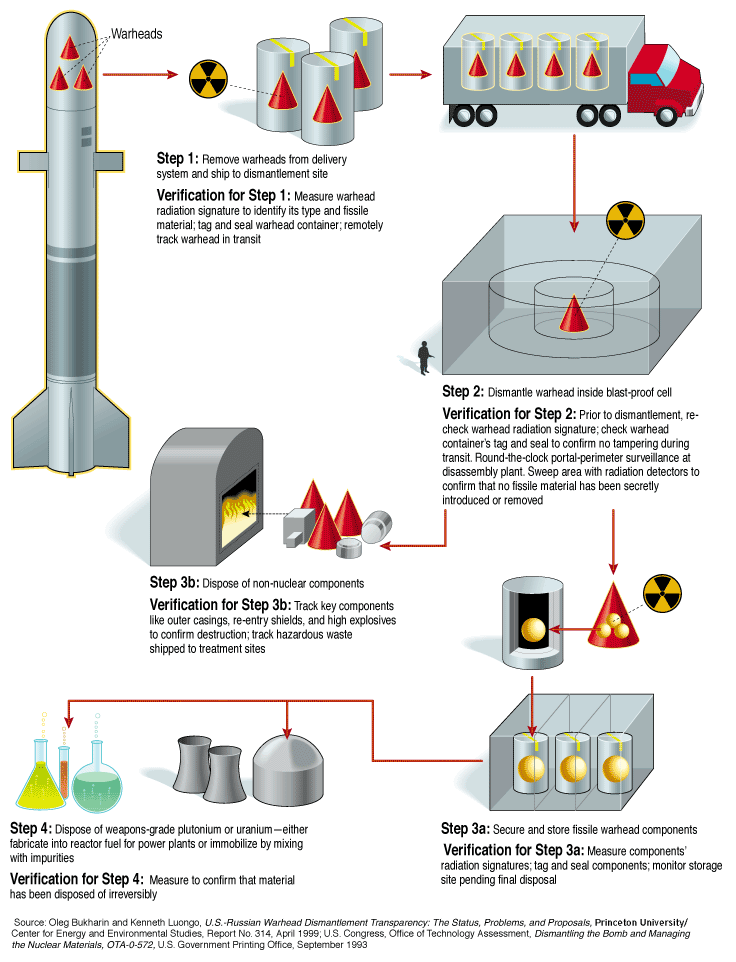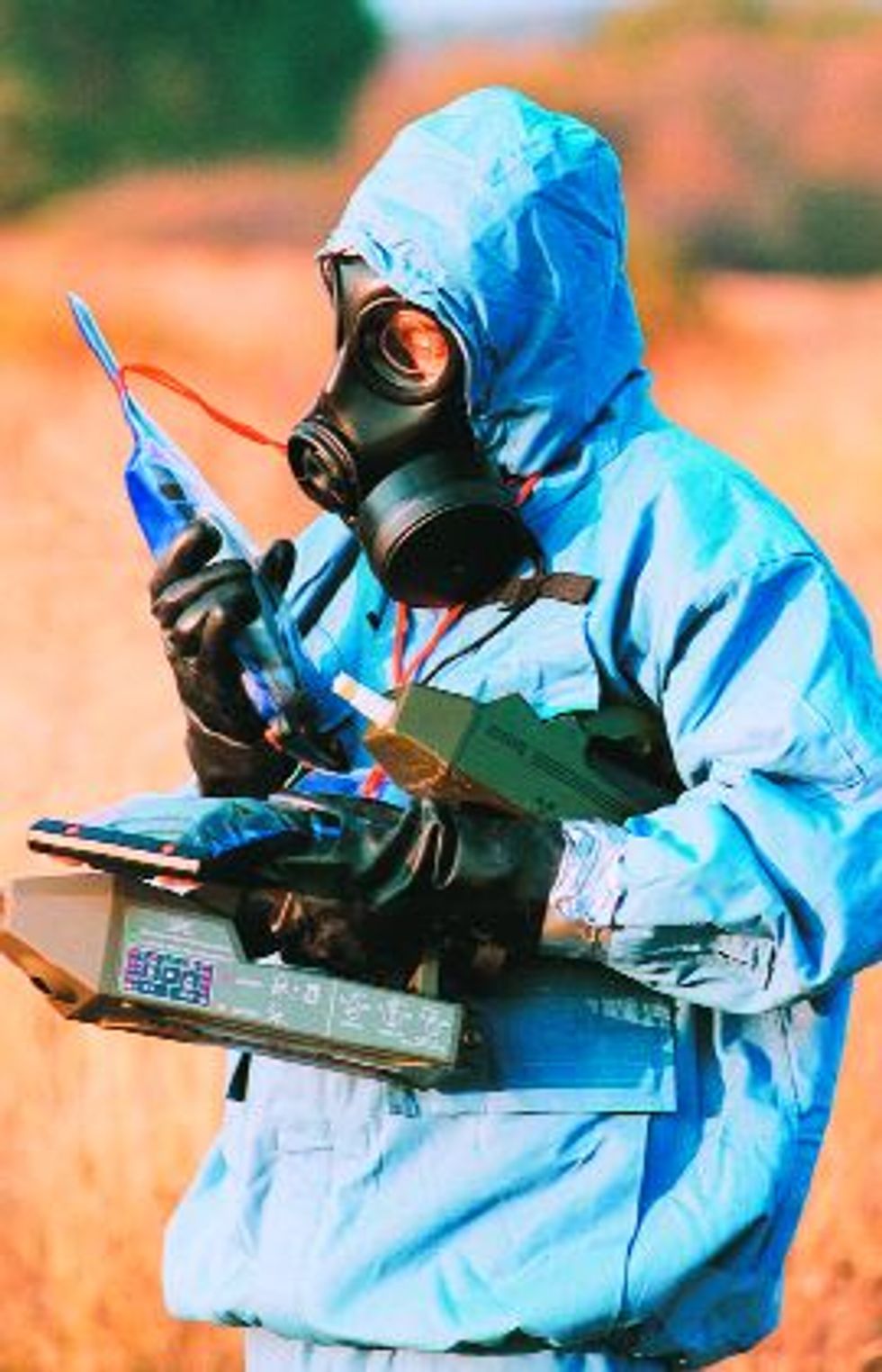A Call To Disarm
Amid fresh fears of a nuclear, chemical, or biological attack, abolition no longer seems a crazy idea

This is part of IEEE Spectrum's special report: Critical Challenges 2002: Technology Takes On
The terrorist attacks of 11 September that claimed some 3000 lives in New York City, Washington, D.C., and Pennsylvania constituted the deadliest ever foreign assault on U.S. soil. What made the event all the more shocking was the realization that the United States' unparalleled military capabilities--above all, its thousands of nuclear weapons and long-range missiles, built up over a half-century at a cost of trillions of dollars and touted as a cornerstone of national security--proved useless, either as a deterrent or as weapons of war.
"The United States has over 10 000 nuclear weapons, and yet they had no effect in deterring a terrorist attack against us, and they obviously have no role to play in prosecuting the military operation in Central Asia," observed Bruce Blair, a nuclear arms control expert and president of the Center for Defense Information, a Washington, D.C.-based think tank. "We don't need them ourselves, and they pose a grave danger to us if they fall into the wrong hands."
Indeed, in contemplating that day's events, and the anthrax-laced letters that followed, our imaginations ran wild, and along the bleakest of paths. We know, although in the last decade we have often chosen to disregard, that modern society has devised and deployed the means to kill, in a single strike, not hundreds or thousands, but millions.
Recent events have brought a renewed urgency to halting the spread of such massively destructive weapons, whether nuclear, chemical, or biological. The concern of the moment is that these deadly devices not fall into the hands of extremists. There may also be a growing sense that what will ultimately make the world a safer place is to eliminate all weapons of mass destruction permanently. As Blair sees it, "September 11 has resurrected what had previously been to most people the far-out agenda of abolition."
Reasons for hope, reasons for despair
With worldwide stockpiles totaling some 22 000 nuclear warheads, 70 000 tons of chemical warfare agents, unknown tons of germ warfare agents--not to mention myriad stores of nuclear fuel and waste that could be turned into radiological weapons--the task of keeping these weapons secure is daunting [see table].
Getting rid of them altogether is a longer-term prospect, and there is no clear means for getting the job done. Certainly, a starting point is to work with existing international accords for preventing proliferation. But to judge by experience, comprehensive disarmament will be complex and politically fraught, treading a fine line between the demands of fairness and openness, on the one hand, and national sovereignty and security on the other.
One may take comfort in knowing that nearly all the world's countries agree on the need to eliminate such weapons. The 1972 Biological and Toxin Weapons Convention and the 1993 Chemical Weapons Convention ban their use and development outright. The Nuclear Nonproliferation Treaty of 1968 is not as far-reaching, but the five nuclear weapons states it recognizes--the United States, Russia, China, France, and Britain--have all pledged to the "unequivocal" elimination of nuclear arms.
Points to Ponder
WORLD WAR I Chemical weapons claimed a million casualties all told, including 100 000 deaths.
CONSENSUS NEAR The Chemical Weapons Convention (CWC), which bans such weapons, has been ratified by 143 countries.
DEADLINE 2007 Under the CWC, all existing stockpiles are to be destroyed in five years' time.
In keeping with that commitment, stockpiles have fallen steadily, albeit not as fast as the nonnuclear states would like. Early December saw the completion of the first strategic arms reduction treaty, signed by the United States and Russia back in 1991; it cut both countries' strategic nuclear warheads and launch vehicles by more than a third. U.S. President George W. Bush recently pledged to cut the number of deployed warheads still further, to somewhere between 1700 and 2200.
What is troubling to many, however, is the Bush administration's across-the-board rejection of treaty-making as the proper approach to arms control, on grounds that it is a glacial and ineffective process that unduly ties U.S. hands. Bush's proposed warhead cuts, for example, are essentially the same as those proposed in 1997 in the Start III agreement--"but without the benefit of irreversibility that a treaty would provide," said Frank von Hippel, co-director of the Program in Science and Global Security at Princeton University, in New Jersey. The United States also refuses to join the 1996 Comprehensive Test Ban Treaty, which forbids nuclear weapons testing, and recently withdrew from the 1972 Anti-Ballistic Missile Treaty with Russia.
Then there was the administration's scuttling of a proposed verification protocol for the Biological Weapons Convention, which aimed to make the 30-year-old treaty finally enforceable [see "Futility of a Toothless Treaty"]. Not only would the draft protocol not catch violators, the administration argued, it would expose the U.S. military's biodefense efforts and open up pharmaceutical companies to industrial espionage. The United States instead proposed that individual countries pass criminal laws forbidding biological weapons, and that the secretary general of the United Nations be authorized to investigate alleged uses of bioweapons and suspicious outbreaks of disease.
The UN has had the latter mechanism in place for 12 years, points out Barbara Hatch Rosenberg, a professor of environmental science at the State University of New York campus in Purchase who directs the Federation of American Scientists' Working Group on Biological Weapons Verification, based in Washington, D.C. As for criminalizing bioweapons, she said, "that's of course a good idea and was in fact [part] of the protocol, where it would have had legal force."
Like many arms control experts, Rosenberg finds the U.S. government's unilateralism deeply troubling. As the world's largest economic and military power, she said, the United States is "setting a terrible example."
We have the technology
Against such a backdrop, what are the prospects for abolition? Moving toward all-out disarmament is hardest in the nuclear arena, where the five original nuclear states, as well as the three de facto ones--Israel, India, and Pakistan--still devote many billions of dollars to maintaining their nuclear arsenals. While attention is now focused on the threat posed by terrorists acquiring such weapons--witness the rampant rumors that Osama bin Laden's al Qaeda network may have been studying up on bomb physics--the danger that one of the nuclear states will unleash an attack is just as troubling.
Inducing the eight countries to dismantle their nuclear arsenals will of course mean contending with whatever their political rationales are for wanting them in the first place [see "Shaking Off the Cold War, At Last"]. For the United States, nuclear weapons symbolize its global military preeminence. For Russia, and to an extent the UK and France, they offset others' superior conventional forces. For China, they are a hedge against Russia and the United States; for India, against China; for Pakistan, against India; and for Israel, against the Arab world.
When contrasted with the politics, the technology for dismantling nuclear arsenals is almost straightforward. One nice thing about nuclear weapons is that they're radioactive, which aids in tracking their presence, absence, and movement. The only ticklish point is ensuring that nuclear components and materials are irreversibly destroyed, and not secretly diverted. To verify dismantlement, "you need a lot of transparency--that is, openness--if you're going to build confidence," said von Hippel.
As described by Oleg Bukharin, a colleague of von Hippel's at Princeton, nuclear dismantlement includes [see diagram at top of page]:
-
Monitoring the removal of warheads from deployed missiles.
-
Monitoring the stored warheads at military bases.
-
Tracking the transport of warheads from storage to a warhead dismantlement facility.
-
Monitoring the elimination of the warheads.
Not long ago, one helpful mechanism was demonstrated for their Russian counterparts by scientists at Los Alamos National Laboratory, in New Mexico. The goal was to confirm whether an object in a sealed container--representing a nuclear warhead--contained plutonium, without giving away any detailed information about the warhead's design. Using information barriers, the experimenters filtered the radiation measurements to yield a simple yes or no answer. In the absence of such precautions, a neutron or gamma-ray detector can reveal such design secrets as the composition and approximate mass of the individual components, Bukharin explained.
Off-the-shelf verification
Remote verification via satellite is also useful. Commercial satellite images proved invaluable in tracking the evolution of North Korea's nuclear program during the early 1990s, for example. Joshua Handler, another researcher in von Hippel's group, has compared recent commercial images of U.S. and Russian weapons sites to declassified photos taken by the U.S. military in the 1970s.
To the untutored eye, the 1-meter-resolution black-and-white and color images, taken by Space Imaging Inc.'s Ikonos commercial satellites and available to the public, reveal little. But to a trained analyst, they speak volumes. Among other things, the Ikonos images reveal new and much-needed security upgrades at nuclear weapons facilities in Russia. And at a few thousand dollars per photo, they're a bargain relative to the billion-dollar spy satellites operated by the Pentagon. (In point of fact, during its campaign in Afghanistan, the Defense Department bought up Ikonos' entire stock of images of that area.)
"As we get closer to zero nuclear weapons, such high-resolution imagery will be a valuable tool in allowing citizens to verify that governments are abiding by their commitments to disarm," Handler said. "How can a government hide a facility from its citizens or the international community if it can be exposed through satellite imagery that is available to all?"
Fear of breakout
Hand in hand with dismantling existing arsenals is preventing the technology from spreading elsewhere. In a world free of weapons of mass destruction, the fear is that a country or group that somehow manages to acquire them will wreak havoc. This is known as breakout, and has been used as an argument for retaining nuclear weapons as a deterrent and as a weapon of last resort.
Although 11 September revealed the flaws in such logic, breakout remains a concern. In that vein, keeping a lid on the thousands of tons of materials usable in nuclear weapons and held by various countries around the world has become a top priority. After 11 September, the U.S. Department of Energy canceled all shipments of fissile materials within the United States. The Washington, D.C.-based Nuclear Control Institute has called for a similar ban on international shipments, along with a halt to the production and use of atom bomb materials, separated plutonium, and highly enriched uranium.
Keeping a lid on the thousands of tons of material that could be used in nuclear weapons is a top priority
Stealing or illegally purchasing such materials, and thereby bypassing the need to produce them from scratch, offers a considerable shortcut to making nuclear weapons. "There are so few indicators of the actual construction of a nuclear weapon," said David Albright, president of the Institute for Science and International Security, in Washington, D.C. "So if somebody steals highly enriched uranium or plutonium from Russia, the chances of detecting the acquisition could very well be zero. And the chance that you'd know they'd built a nuclear weapon is also likely to be zero. You may get lucky, but it's very difficult."
Until now, the assumption has been that catching such nuclear thefts was a national, not international, responsibility. ["Making Intelligence Smarter", discusses how to improve U.S. intelligence gathering; "Improving Security, Preserving Privacy", reviews developments in security technology.] Such surreptitious acts would tend to fall below the radar of the International Atomic Energy Agency (IAEA), the Vienna, Austria-based organization that polices the Nuclear Nonproliferation Treaty, said Albright. He suggests that some new type of international monitoring organization may be called for, one with broader intelligence-gathering and law-enforcement abilities.
Ironically, the original vision for the IAEA was just that. The Baruch Plan of 1946, named for its creator, Bernard M. Baruch, the U.S. representative to the UN Atomic Energy Commission, called for the creation of an international atomic energy development authority, which would directly control all nuclear activities worldwide. Under the plan, no country was permitted atomic weapons; as the then-sole nuclear power, the United States would have had to destroy its stockpile, while the USSR would have had to open up its nuclear installations to international inspection. Amid U.S.-Soviet wrangling over the exact terms, an early skirmish in the Cold War, the plan was shelved.
Reining in the rogues
Those who believe that international arms control efforts cannot catch someone hell-bent on breakout like to cite the case of Iraq. Although the Iraqis carried on an extensive nuclear weapons program for nearly a decade leading up to the Gulf War, it was never detected by IAEA inspectors.
Iraq was able to exploit a huge loophole in the Nuclear Nonproliferation Treaty. According to IAEA rules, inspectors visited only those facilities that Iraq declared as having nuclear materials; meanwhile, its entire weapons complex was kept under wraps.
The IAEA readily admits it made mistakes. "The assumption was that a country that had signed the treaty would faithfully respect its agreement," explained Jacques Baute, head of the special IAEA team assigned "to investigate and neutralize Iraq's clandestine program" after the Gulf War.
To do that, IAEA inspectors took a more aggressive "anywhere, anytime" approach. The team interviewed key Iraqi scientists, demolished military facilities, and confiscated weapons-grade material, Baute said. Their efforts continued until December 1998, when Saddam Hussein discovered that IAEA data was being fed to the U.S. government and countered by maneuvering the inspectors out of his country. Shortly thereafter the United States and Britain began a bombing campaign there, and Iraq has since refused to let the IAEA team return.
Stronger safeguards
The experience in Iraq as well as in North Korea, which also tried to conceal a nuclear weapons program, persuaded the IAEA to beef up its verification regime, referred to by the agency as safeguards. Inspectors now take environmental samples near known and suspected nuclear sites, looking for trace amounts of radioactivity in the air, water, soil, and vegetation. "From that we can get a signature of activities [of] the recent past," explained IAEA spokesperson David Kyd.
For more extensive, continuous observation, it may one day be possible to do wide-area environmental monitoring, placing radiation detectors every few kilometers or so to create a huge grid. The sensors would sample the air, looking for krypton 85, a signature of spent fuel being reprocessed to recover plutonium, or for uranium hexafluoride leaking from a clandestine centrifuge producing highly enriched uranium. Constructing and maintaining such a network on a global basis would be prohibitively expensive, noted David Albright, but one could conceivably deploy such sensor arrays selectively, in areas of greatest concern.
IAEA staffers also now regularly scan the international press, technical literature, and other sources, looking for hints of surreptitious activity. Steady improvements in verification technology have also helped, including gamma-ray and neutron detectors for sensing the radionuclides given off by nuclear materials and components; video surveillance cameras for monitoring nuclear facilities; tamper-deterrent seals and tags to be placed on nuclear materials during storage or transportation; and advanced clean-room laboratory facilities for analyzing samples.
Even so, admitted Kyd, "we're not very far along." Among the 180 countries that have signed the Nuclear Nonproliferation Treaty, only 22 have agreed to the new safeguards, and of that group, only Canada and Japan have nuclear industries of any consequence. Nor does the IAEA have the funding to fully implement the safeguards; in real terms, its annual budget has remained flat at about $230 million since 1986 [see "Help Wanted," on the pressing need for technically trained arms control experts]. That in turn points to a chief criticism of the IAEA: as an international bureaucracy run by consensus, it can move only as fast and as far as its member states will allow.
But agility and aggressiveness, plus a healthy skepticism, are exactly the qualities needed for spotting a breakout, argues Albright, who participated in some of the IAEA inspections in Iraq. He sees the agency as being hamstrung by political compromise and its own complacency. "If we're going to verify disarmament, inspectors have to have free access and the ability to conduct no-notice inspections," he said. "No country is currently willing to grant [the IAEA] that right."
A weapon or a pillow?
Compared to nuclear weapons, the outlook for getting rid of biological and chemical weapons is better, but by no means good. Better because, unlike in the nuclear case, all countries that sign the chemical and biological weapons treaties agree to give up developing, owning, or using these weapons.
What hampers chemical and biological disarmament is that illicit work can more easily be masked by legitimate activities. "Chemicals exist in industry for various permitted purposes, and you can't tell what's in the heart of the user--whether they're going to be used as a pesticide, say, or modified and used as a chemical weapon," noted Thomas Cataldo. He heads the technical support branch for the Organization for the Prohibition of Chemical Weapons (OPCW), based in The Hague, the Netherlands, which administers the Chemical Weapons Convention.
Take phosgene, a powerful lung irritant that was a weapon of choice in World War I. "Hundreds of thousands of tons of phosgene are now used throughout the world every year--they're used to make the seat cushion in your chair," Cataldo explained. "So is a cylinder of that a chemical weapon if it's being carried in a van going down the street? No. But could it be used as one? Yes." To detect such a small quantity of chemicals before it is misused would be impossible, Cataldo said.
Still, the OPCW has far greater latitude than its nuclear counterpart in Vienna. For one thing, chemical weapons inspectors visit military and industrial sites alike [see photo], and also oversee the destruction of chemical weapons stockpiles in the United States, Russia, India, and South Korea. Inspectors are also empowered to conduct so-called challenge inspections of sites suspected of harboring a secret weapons effort. "We'll go turn over rocks, look in bunkers, or check to see if a former weapons facility has been used in the recent past," explained Cataldo.
But like their IAEA counterparts, the chemicals inspectors must be mindful of their hosts' sensitivities. For example, the private labs they inspect may have some proprietary process or data. To accommodate their desire for secrecy, the OPCW has been developing so-called blinding software. Analogous to the nuclear information barriers developed at Los Alamos, it scrambles the details of a spectroscopic readout so that only the presence or absence of a certain chemical is revealed.
Having an international verification authority like the OPCW does not absolve individuals of their responsibility in stopping proliferation, Cataldo added. "I think the chemical weapons convention makes private companies and nations aware that they need to take precautions to safeguard their materials, for their own safety and self-interest and for others."
A role for civil society
While international verification efforts may never be perfect, they do establish a universal norm that weapons of mass destruction must be eliminated. In the end, what will propel disarmament forward is not simply better inspection methods or technology but collective political will.
"Our governments will never have full confidence in their own intelligence, in the technical means of verification, or even in mutual inspection rights," said the Center for Defense Information's Bruce Blair. "The problem of compliance is too difficult, and the significance of small-scale cheating will loom larger as we approach zero."
Here, the role of citizen activists and nongovernmental organizations may prove pivotal. Already, they have provided much of the impetus for prodding reluctant governments to engage in arms control and disarmament, even when such issues were drawing little public notice. "What's really going to make or break [abolition] is winning grass-roots support for implementation," observed Pamela Mills, an OPCW researcher.
What will propel disarmament forward is not better inspection technology but collective political will
British physicist Joseph Rotblat, whose decades-long effort to abolish nuclear weapons earned him a Nobel Peace Prize in 1995, has suggested one mechanism for involving ordinary citizens. His idea for citizen verification, as he calls it, would encourage anyone who knew about clandestine weapons plans to report those activities, perhaps anonymously through the Internet.
Disarmament demands a social framework that values openness, said Blair. "The Russians have confidence that the United States is not systematically cheating on arms control--not because of what their [reconnaissance] satellites tell them, because in fact their satellites have stopped functioning, [but] because they know that we as a society uncover our own cheating," by virtue of an active civil society, healthy democratic institutions, and freedom of the press.
"That's the state of civilization we're going to have to reach in order to become fully confident in abolition," Blair said. "The solution is going to be found in the development of civil society in the countries of concern."
To Probe Further
Over the years, IEEE Spectrum has investigated various aspects of weapons of mass destruction. "Unconventional Nuclear Weapons" [November, pp. 54-55] explored the threat from radiological, or dirty, bombs made from radioactive material. "Biological Warfare Canaries" [October, pp. 35-40] described recent efforts to develop ways of detecting biological weapons. The deterioration of Russia's nuclear weapons complex, as well as stagnation in moving beyond Cold War strategic planning, were described in a special report in March 2000.
A September 1997 special report looked at the many technical challenges to building a ballistic missile defense system. "Better Networks for Test Ban Monitoring" [February 1996, pp. 24-33] discussed advances in technology for remotely detecting nuclear tests. And "How Iraq Reverse-Engineered the Bomb" [April 1992, pp. 20-23, 63-71] investigated the Iraqi nuclear weapons program, which came to light after the Gulf War.
To get an idea of how the blast from a 1-megaton hydrogen bomb might affect your home or office, go to the Nuclear Blast Mapper Web site at https://www.pbs.org/wgbh/amex/bomb/sfeature/mapablast.html (works for U.S. locations only).
"Engineer for Hire," by David Albright, describes how Bruno Stemmler, a German physical chemist, was unwittingly recruited to work on Iraq's then-clandestine nuclear weapons program. Read it at https://www.bullatomsci.org/issues/1993/d93/d93Albright.html
An accurate and official accounting of the world's nuclear arsenal is considered a prerequisite for disarmament. None of the nuclear weapons states currently publishes such data, but independent analysts have managed to glean reasonable estimates from the public record. See, for example, Robert S. Norris and William M. Arkin's Nuclear Notebook column in the Bulletin of the Atomic Scientists, available at https://www.thebulletin.org/issues/nukenotes/nd01nukenote.html
Also noteworthy is Pavel Podvig's Russian Strategic Nuclear Forces (MIT Press, Cambridge, Mass., 2001). The FSB (Russian Federal Security Service) confiscated the Russian edition of this book, so you know it must be good.
Jonathan Schell's The Gift of Time (Metropolitan Books, New York, 1998) elegantly makes the case for nuclear disarmament. A technically more rigorous strategy is described in The Nuclear Turning Point (Brookings Institution, 1999), edited by Princeton University's Harold A. Feiveson.
Oleg Bukharin and Kenneth Luongo's "U.S.-Russian Warhead Dismantlement Transparency: The Status, Problems, and Proposals," was issued in April 1999 by Princeton University's Center for Energy and Environmental Studies. The report surveys the technical and political issues surrounding verification that nuclear warheads have been dismantled. Look up https://www.ransac.org/new-web-site/pub/reports/transparency.html
Also of interest is "Dismantling the Bomb and Managing the Nuclear Materials," a September 1993 report by the now-defunct U.S. Office of Technology Assessment. The 202-page report is at https://www.wws.princeton.edu/~ota/disk1/1993/9320_n.html





